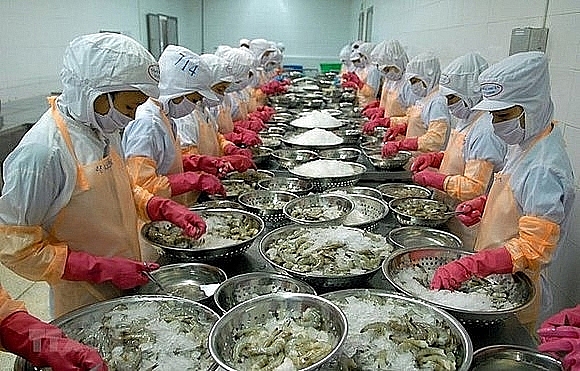 |
| Shrimp exports have decelerated since June 2022 |
According to the Vietnam Association of Seafood Exporters and Producers (VASEP), after strong growth of 39-62% in the first four months of 2022, seafood exports have been showing signs of slowing down since May.
Exports increased by 34% in May and 18% in June. In July, seafood exports continuously decelerated, with an export value of US$970 million, up 14% over the same period in 2021 and down 4% compared to June 2022.
Due to adverse weather, such as rain coming earlier than most years, the production of aquatic products, causes diseases for farmed shrimp. This has led to a decrease in shrimp production, and stocks from last year have also been depleted.
Which, shrimp – the main export product – tended to decrease significantly in some markets. From June, export turnover decreased by 1% over the same period last year because of a shortage of raw materials. In July, shrimp exports continued to decrease by nearly 13%, reaching US$385 million. Accumulating seven months, shrimp exports brought US$2.65 billion, up 22% over the same period last year.
According to Le Hang, Deputy Director of VASEP.PRO Center, domestic shrimp production and world shrimp demand are not expected to be positive in the last months of the year. Shrimp supply of producing countries increased sharply, the import volume of main markets such as the US and the EU increased in the first half of the year, which will lead to an increase in inventories and a slowdown in demand in the second half.
Furthermore, the domestic production of raw shrimp is facing difficulties because of the weather and high costs, so there will continue to be a shortage of raw shrimp in the second half of this year, affecting enterprises’ fulfillment of export orders.
Unlike shrimp, the source of pangasius material is not a big problem, but import demand also tends to slow down in some markets. Therefore, pangasius exports also slowed down in the second quarter. In July, pangasius exports reached US$197 million, up 56%, accumulated by the end of July 2022, pangasius exports reached more than US$1.6 billion, up 79% over the same period in 2022.
Faced with the impact of inflation and the increasing trend of export prices in other countries, import demand of some markets also has appropriate changes. Pangasius is also an advantageous commodity when inflation has been too high in many markets, consumers will tighten their spending, turning to reasonable products such as frozen pangasius fillets or fish cakes, surimi, as well as other frozen products.
Exports of tuna, other sea fish, squid, and octopus maintained a high growth rate of 37-44% in July. By the end of July 2022, tuna exports increased by 53% to US$641 million, squid and octopus exports increased by 31% to US$417 million and other sea fish species increased by 16% to over US$1.1 billion.
Rising inventories coupled with inflation have impacted the US import demand since June. Therefore, Vietnam’s seafood exports to this market decreased by 8% in June and continued to fall deeply by 23% in July. Accumulated in the first seven months of the year, exports to the US reached nearly US$1.5 billion, up 31% compared with the same period last year.
Exports to the EU maintained a growth rate of 28% in July and accumulated in seven months, it reached US$829 million, up 39% over the same period in 2021.
In particular, seafood exports to China after the first seven months of 2022 reached US$1 billion, up 71% over the same period in 2021.
China recently announced that they would check online shipments to detect the SARS-CoV-2 virus. If SARS-CoV-2 is detected, it is necessary to fully prepare relevant contents (facilities, equipment, personnel, records, documents, results investigation, and appropriate remedial measures) to serve the online inspection in accordance with the deadlines required by the Chinese authorities. This measure will be more favorable for Vietnamese seafood exporters than before.
However, according to the recommendation of Bui Hoang Yen, Deputy Head of the Southern Working Group, Trade Promotion Department – Ministry of Industry and Trade, to promote seafood exports to markets, businesses need to focus on solving two outstanding issues; quality and food safety, especially the issue of traceability and quality certification. Along with that, speed up the negotiation process to expand the officially exported list; continue to accelerate restructuring towards building concentrated specialized farming areas of uniform size and quality to meet export standards.
However, according to VASEP’s assessment, the scarcity of raw materials for shrimp and seafood will continue to influence Vietnam’s seafood exports in the third quarter. Accordingly, it is forecasted that the 3rd quarter would grow slower than the 2nd and 1st quarters, estimated at about US$3 billion.
